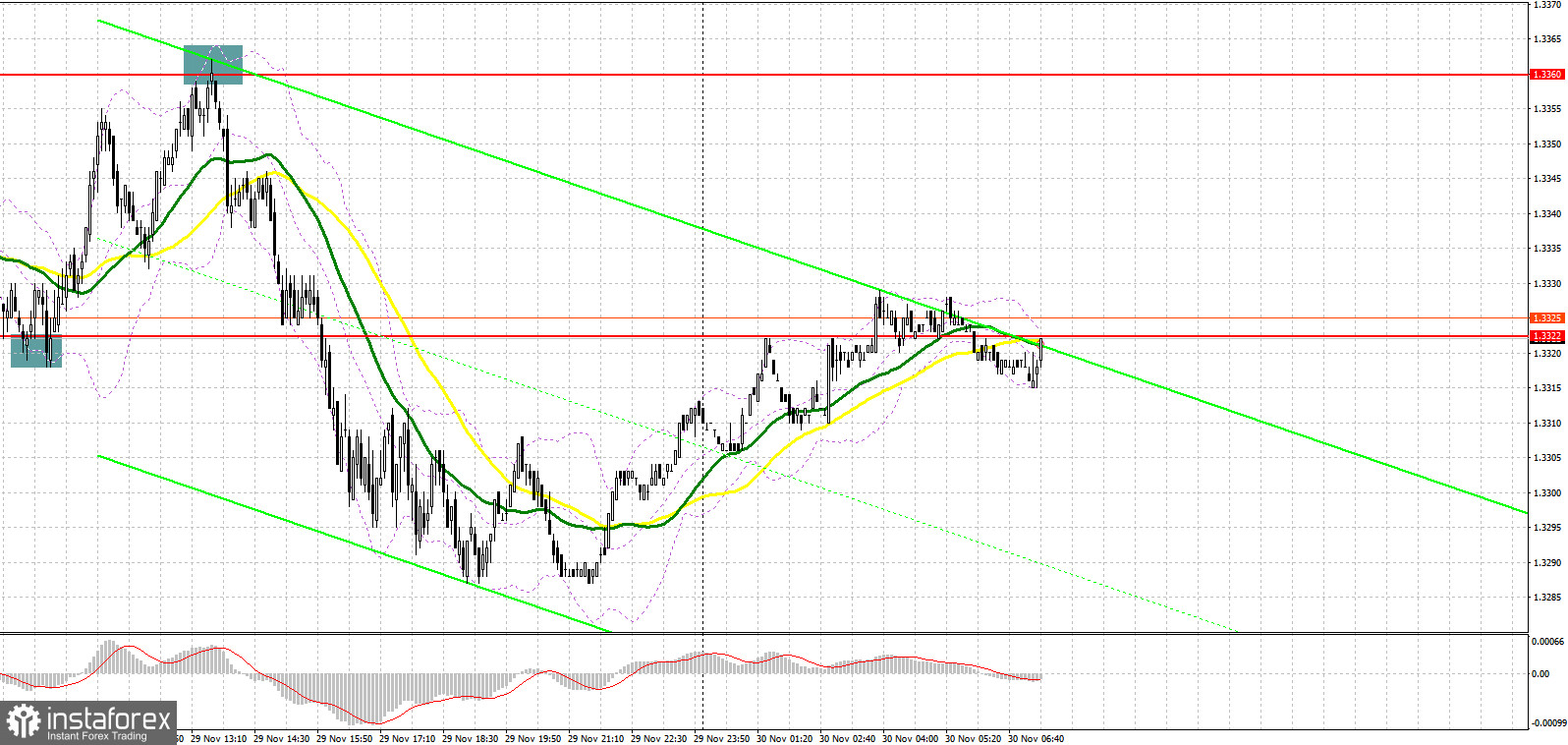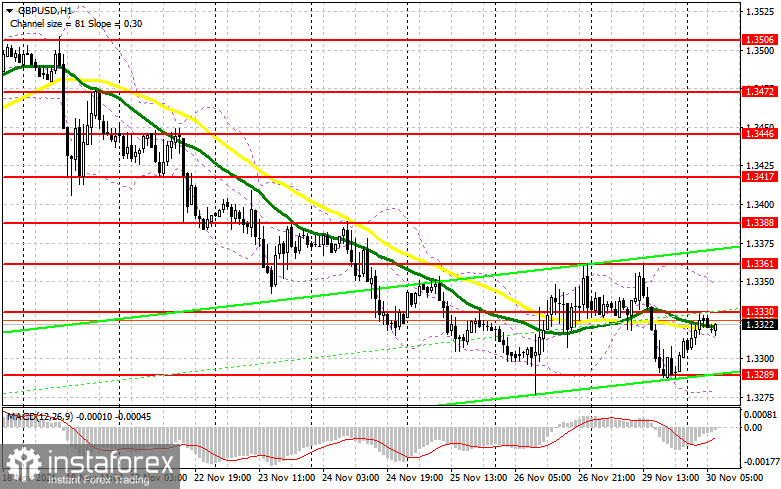To open long positions on GBP/USD, you need:
Several excellent signals to enter the market were formed yesterday. Let's take a look at the 5 minute chart and understand the entry points. In my morning forecast, I paid attention to 1.3322 and advised you to make a decision from it. Failure to settle below 1.3322 and a false breakout resulted in forming a good entry point into long positions. As a result, the upward movement amounted to more than 40 points and the bulls achieved the renewal of resistance at 1.3360. An unsuccessful attempt to consolidate above this range and good statistics on the American economy resulted in forming of a false breakout and a signal to sell the pound, followed by a fall by more than 70 points.
Before examining the technical picture of the pound, let's take a look at what happened in the futures market. The Commitment of Traders (COT) reports for November 23 revealed that short positions increased and long positions decreased, which led to an even greater increase in the negative delta. The dovish statements of the Bank of England governor from last week kept the pressure on the British pound, even amid risks associated with higher inflationary pressures than previously expected. The aggravation of the situation with the coronavirus and the new Omicron strain in the European part of the continent did not add optimism. It is also not clear what is with the issue of the Ireland protocol, which the UK authorities are planning to suspend. At the same time, we are witnessing a rise in inflation in the United States of America and increased talk about the need for an earlier increase in interest rates next year, which is providing significant support to the US dollar. However, I recommend sticking to the strategy of buying the pair in case of very large falls, which will occur against the background of uncertainty in the central bank's policy. The COT report indicated that long non-commercial positions declined from 50,443 to 50,122, while short non-commercials rose from 82,042 to 84,701. This led to an increase in the negative non-commercial net position: delta was -34,579 against -31,599 a week earlier. The weekly closing price did not drop that much - from 1.3410 to 1.3397.

Today we have absolutely nothing according to fundamental UK statistics, so trading is expected to remain in a horizontal channel with a slight advantage for pound bears. The trend is downward. The bulls' main task in the first half of the day is to protect the immediate support at 1.3289, which is located in the immediate vicinity near the monthly low. Only the formation of a false breakout there, along with good news on the coronavirus, forms a signal to buy the pound against the trend. This will return the chance for an upward correction of the pair to the resistance of 1.3330, which was formed at the end of yesterday. There are moving averages slightly below this level, which really limit the pair's upward potential. An equally important task is to regain control over this level. A breakthrough and reverse test from top to bottom at 1.3330 will provide another buy signal, which will lead to GBP/USD moving up to the 1.3361 area with the prospect of reaching a high like 1.3388, where I recommend taking profits. In case the pair falls in the first half of the day and traders are not active at 1.3289, the best option for buying the pound will be a test of a new low at 1.3227. However, I advise you to open long positions there only after a false breakout. You can watch long positions of GBP/USD immediately for a rebound from a new low of 1.3189, or even lower - from support at 1.3139, counting on a correction of 25-30 points within the day.
To open short positions on GBP/USD, you need:
Yesterday, the bears coped with their tasks only in the second half of the day. Most likely, the pressure on the pound will continue today, as there are no real preconditions for a trend reversal so far. The best option would be to form a false breakout at 1.3330, where the moving averages pass, which will lead to the formation of the first entry point to short positions, followed by a decline in GBP/USD to the 1.3289 area. A breakthrough of this range will be a no less important task for bears, as it will lead to renewal of the next monthly lows and the preservation of the downward trend for the pair. The test of 1.3289 from the bottom up forms an additional signal to open new short positions further along the trend with the goal of falling to the lows: 1.3227 and 1.3189, where I recommend taking profits. In case the pair grows during the European session and there are no bears at 1.3330, it is best to postpone selling to the larger resistance at 1.3361, which is also the upper border of the current intraday horizontal channel. I advise you to open short positions immediately on a rebound from 1.3388, or even higher - from a new high in the 1.3417 area, counting on the pair's rebound down by 20-25 points within the day.

Indicator signals:
Moving averages
Trading is carried out just below the 30 and 50 moving averages, which indicates an attempt by the bears to keep the market under their control.
Note: The period and prices of moving averages are considered by the author on the H1 hourly chart and differs from the general definition of the classic daily moving averages on the daily D1 chart.
Bollinger Bands
A breakthrough of the upper border of the indicator in the area of 1.3350 will lead to a new wave of growth of the pound. A breakout of the lower border of the indicator in the area of 1.3285 will increase the pressure on the pair.
Description of indicators
- Moving average (moving average, determines the current trend by smoothing out volatility and noise). Period 50. It is marked in yellow on the chart.
- Moving average (moving average, determines the current trend by smoothing out volatility and noise). Period 30. It is marked in green on the chart.
- MACD indicator (Moving Average Convergence/Divergence — convergence/divergence of moving averages) Quick EMA period 12. Slow EMA period to 26. SMA period 9
- Bollinger Bands (Bollinger Bands). Period 20
- Non-commercial speculative traders, such as individual traders, hedge funds, and large institutions that use the futures market for speculative purposes and meet certain requirements.
- Long non-commercial positions represent the total long open position of non-commercial traders.
- Short non-commercial positions represent the total short open position of non-commercial traders.
- Total non-commercial net position is the difference between short and long positions of non-commercial traders.





















